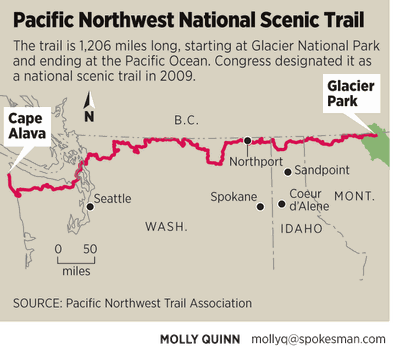Pacific Northwest Trail offers lesser traveled trek through Idaho, Washington

About 20 people hike the length of the Pacific Northwest National Scenic Trail each year, starting at Glacier National Park and trekking 1,200 miles to the Pacific Ocean.
The trail doesn’t have the cachet of the Pacific Crest or Appalachian trails, which attract hundreds of hikers who go the whole distance, said Matt McGrath, the trail’s program manager.
But the Forest Service is looking for ways to publicize and increase use of the newer and lesser known Pacific Northwest trail, which incorporates gems of the Idaho Panhandle and northeast Washington, including the Salmo-Priest Wilderness; the historic towns of Metaline Falls and Northport; and the steep ridges of the Kettle Crest range.
“Most of this is passing through a lot of remote areas – places people don’t get a chance to see traveling the roads,” said Jason Kirchner, a spokesman for the Idaho Panhandle National Forests. “It always feels like the deep, dark woods to me.”
First conceived of in 1970, the trail was established as a national scenic trail by Congress in 2009. Even though it’s had an official designation for five years, parts of the trail are still being developed and refined, McGrath said.
In North Idaho, for instance, he’s interested in bringing the trail about 10 miles farther south to connect with the community of Bonners Ferry. In other areas, he wants to move the trail off roads. And all along the route, he’s interested in input from rural communities, which could help promote the trail through ecotourism efforts.
“People like to talk about going from one end to the other, but not everyone has time for a 1,200-mile trip,” McGrath said. “We’re really focused on day trips or the shorter, overnight trips. This trail goes through a lot of small towns. … There’s great, two-day hikes outside of Bonners Ferry” and other communities.
The push to promote the trail comes amid a renewed national interest in backpacking, Forest Service officials said.
“At certain times in their lives, people want to disconnect from our mainstream society and go reconnect with nature,” said Franklin Pemberton, spokesman for the Colville National Forest, which includes 125 miles of the trail. “We’re seeing a lot of it in popular culture and literature.”
He’s gotten more inquiries from people about backpacking since the publication of Cheryl Strayed’s 2012 bestseller, “Wild: From Lost to Found on the Pacific Crest Trail.” Strayed’s memoir is scheduled for a movie release later this year.
The Pacific Northwest National Scenic Trail starts at the Continental Divide, passing through the dark, wet forests of the Idaho Panhandle and the alpine terrain of the Salmo-Priest Wilderness before dropping into the historic mining community of Metaline Falls. It passes through Northport, traverses the rugged “Wedge” territory near the Canadian border and also incorporates the 45-mile Kettle Crest Trail before moving off the Colville National Forest.
The Kettle Crest Trail, with views of 7,000-foot peaks, is already a popular destination for backpackers, Pemberton said.
The 1,200-mile route mostly uses existing trails, about 850 miles on federal lands. The value in the designated route is that it helps hikers travel across different landownerships without extensive consultation with topographic maps and GPS coordinates, Pemberton said.
“It makes it more accessible,” he said. “I know if I get on this thing in Glacier, I can hike it to the Pacific Ocean.”